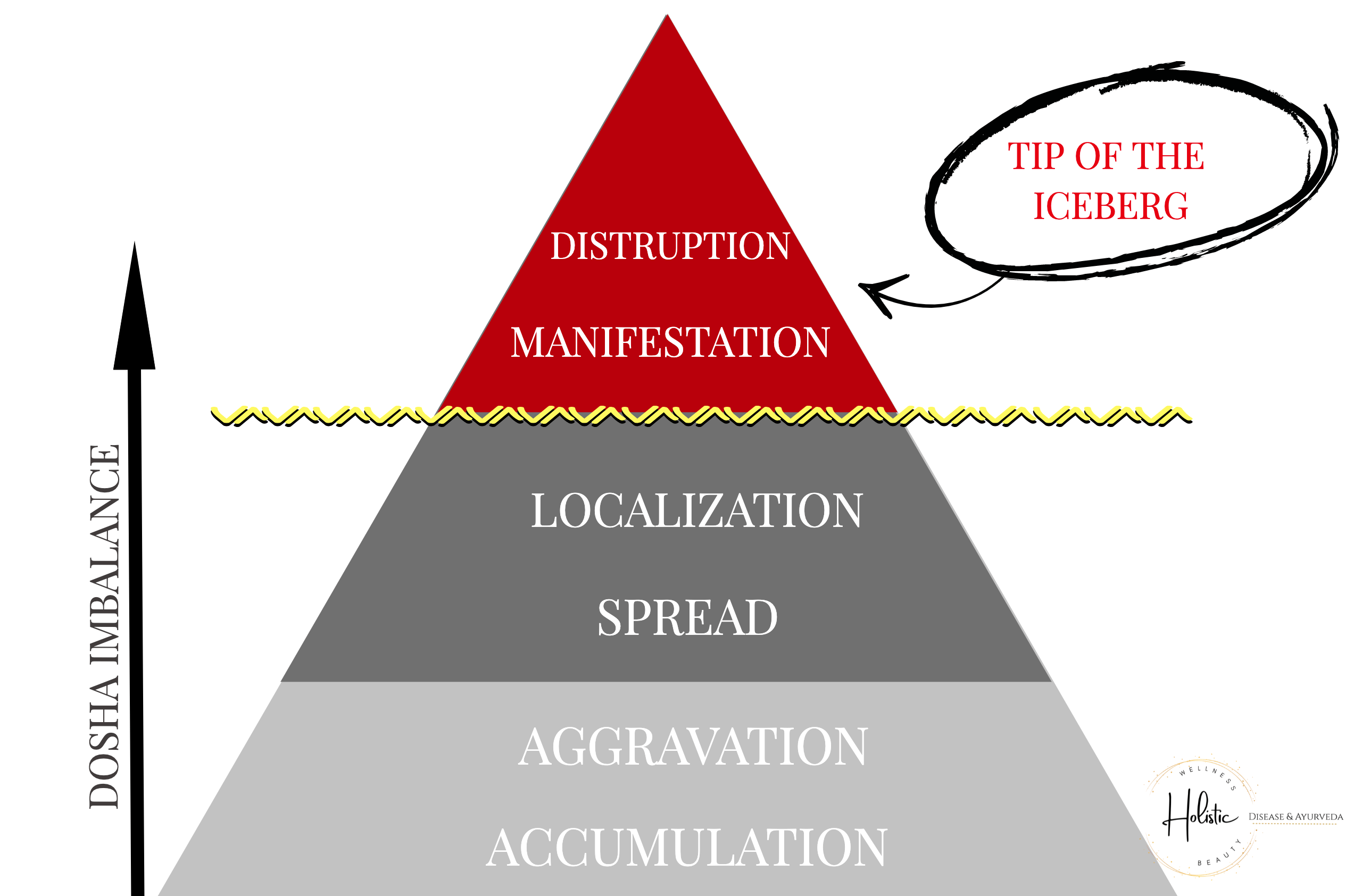Ayurveda offers a framework for understanding individual differences and how to harmonize with them to maintain balance in the face of change in order to enjoy a long, vital life. These differences are captured by the Sanskrit word Prakriti, which means manifest Nature. Individual Prakriti is most simply described as a proportion of the three Doshas Vata, Pitta and Kapha, which respectively reflect movement, metabolism and structure in mind and body. The Doshas act as a buffer to help insulate us from changes induced by the cycles of nature.
Diseases are many. Imbalances are few. Disease is merely the tip of the iceberg of imbalance. Six stages of Dosha imbalance can be assessed from the radial pulse, signs and symptoms.
This is the power of Ayurveda: to identify and correct imbalances when they are easy to treat—before they lead to irreversible changes. A Dosha first accumulates in its proper place. This stage is often accompanied by a natural desire for those things that will restore balance according to the Principle of Similars and Opposites. For example, if we are feeling cold, it would be natural to desire warm food and drink.
If the Dosha continues to accumulate, then it will become aggravated. At this stage, spontaneous desires can become perverse. We can crave more of whatever is throwing us out of balance—for example, feeling hot, yet continuing to eat hot, spicy food and drink alcoholic beverages— creating a vicious cycle. At some point, an aggravated Dosha will spill out of its place. Where does it go? Into the places of the other Doshas. This disturbs their function and often gives rise to more significant “pre-clinical” symptoms.
Now, if the progression is not corrected, the aggravated Dosha will get stuck in places of weakness, particularly where the fine channels of the body (Shrotas) are blocked by Ama. Localization is the final prelude to manifestation of disease. The stage is commonly accompanied by prodromal symptoms of disease as recognized by western medicine. Once a diagnosable disease finally erupts, there still may be opportunity to reverse the process before it becomes severe or chronic. In general, western medicine does a good job of handling life-threatening disease, even if it fails to correct the imbalances that gave rise to it.
Patterns of Disease
By the time disease erupts, often more than one Dosha is involved. Nevertheless, the qualities of the Doshas can be compared to the qualities that characterize the disease and used as a guide to identify which Dosha is the chief culprit. Diseases involving a single Dosha are generally curable. Those involving two Doshas can usually be treated, even if the treatment is difficult. When all three Doshas are involved, palliation may be possible, but because of the inter-relationships among them, the treatment of any one will tend to aggravate one or more of the others. That’s a situation we would all want to avoid.
Dosha imbalance often manifests as indigestion. Because healthy digestion is essential for making healthy tissues, we always give priority to fixing indigestion. The digestion questionnaire will help identify which Dosha might be causing problems there. If a Dosha is disturbing digestion, then it will likely be contributing to problems elsewhere.
Vata Dosha, having qualities of Space and Air, is the most ethereal of the Doshas. For this reason, it is the one that is most likely to go out of balance. Vata causes twice as many diseases as Pitta. In turn, Pitta causes twice as many diseases as Kapha. Kapha is inherently stable, so it is difficult to throw it out of balance. When Kapha does get aggravated, it most likely manifests as a problem with weak digestion and Ama. Other symptoms related to disturbances of the functions of Kapha most often result from Vata or Pitta moving into its place. So, when in doubt, if Ama is not prominent, assume the problem is related to Vata or Pitta
Pitta imbalance is typically characterized by redness, burning sensations, heat or inflammation. Vata imbalance will typically manifest as irregularity, pain, dryness or weakness. Think of stress. Stress is one of the major causes of disease. Stress hits hard on that aspect of Vata involved with the mind. It also depletes Ojas, the source of strength, vitality and immunity. Meditation such as TM provides an antidote. This is one mechanism accounting for its effectiveness in promoting health in a holistic way. Beyond this, the best long term strategy is to recognize and deal with imbalances of the Doshas before they lead to problems.
A pulse reading is the most accurate method to assess for imbalance, but this brief questionnaire is an easy place to start. It catalogues common results of imbalances in Vata, Pitta and Kapha.
Instructions for Completing the Dosha Imbalance Questionnaire
- Respond to every item.
- Please enter your email. That way you will receive a copy of the report.
- All information entered here will be kept confidential according to our Privacy Policy.



